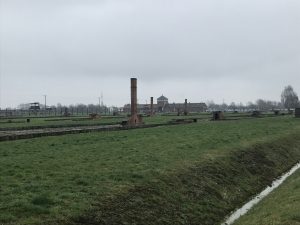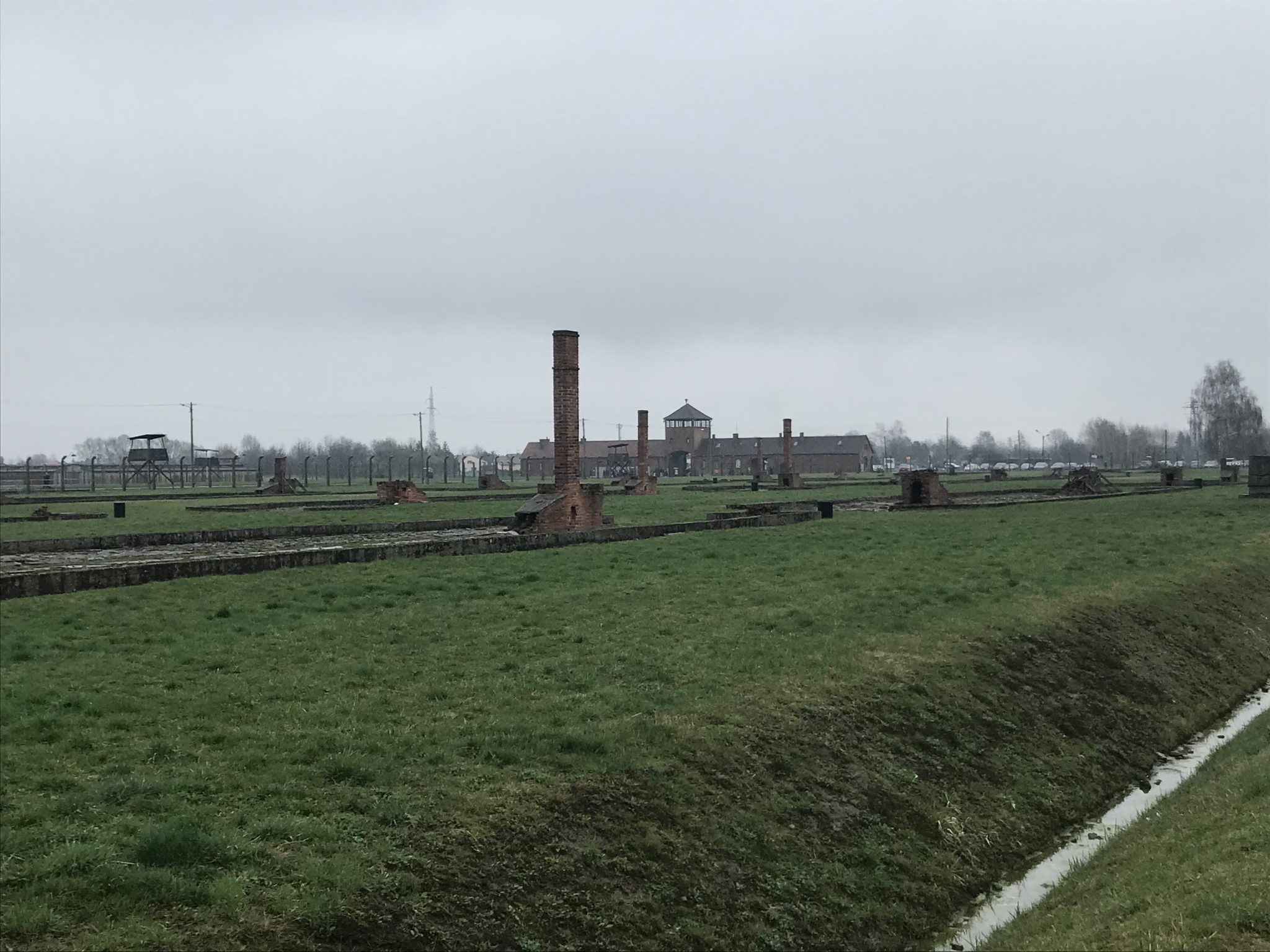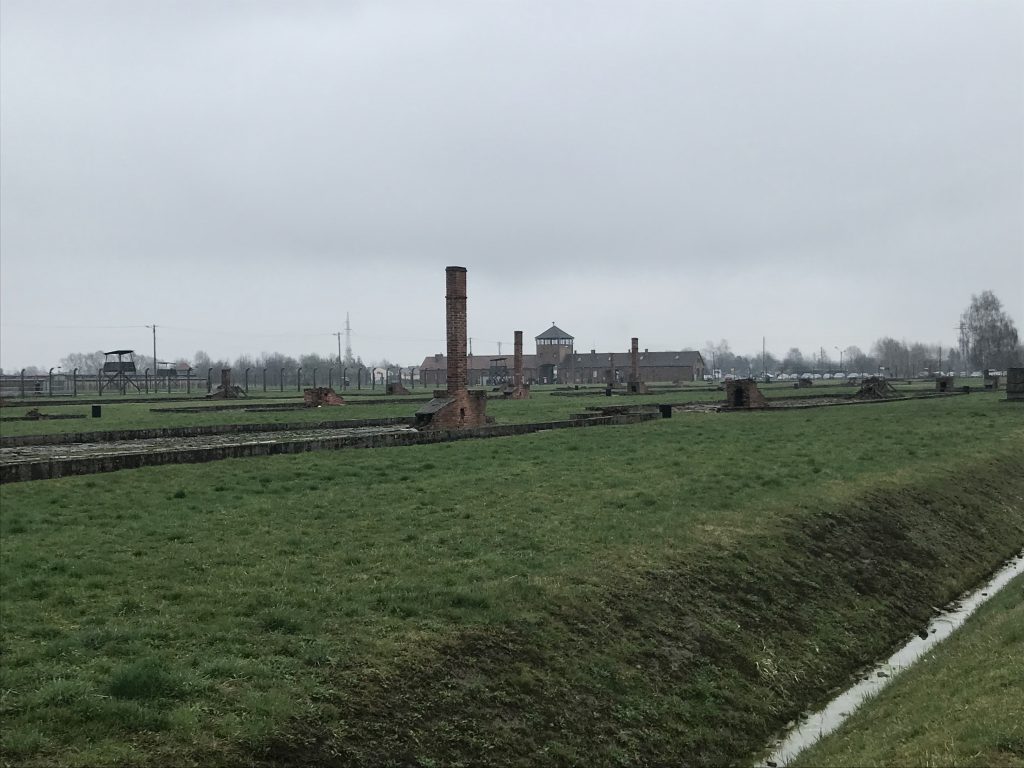Natania ’24, shares a reflection of an impactful visit to Auschwitz.
Auschwitz II-Birkenau holds what is probably the most recognizable physical symbol of the oppression that the Jews faced during the second World War. I don’t want to say that seeing its entryway will make you understand the scale of the six million Jews who were murdered, or even the one and half million people killed directly in Auschwitz, as it didn’t for me, but it takes up space in history. The Auschwitz-Birkenau gate is the one you see in high-contrast black-and-white pictures, railroad tracks going straight through the center. It looms.
One thing that has struck me throughout this trip has been the utter hate that the Nazis held for Jews. They were treated as worse than animal, despised as vermin in a way that you could never hate a rat. Eighty percent of the Jews arriving at Auschwitz were selected to be killed on arrival. We went inside a barrack in Auschwitz-Birkenau which would have held seven hundred people. It had three tiers of beds: stone ground, first wooden shelf, second wooden shelf. The rows and rows of barracks, each one containing hundreds of people, were for just one fifth of the arrivals.
We also saw the remains of a basement that had once been a gas chamber. We looked at the crematorium in the distance. It had the capacity to burn 4,000 bodies a day. People in the barracks were forced to fight for a ‘nicer’ spot on the top bunks. The stone floor would have been filthy, with waste and bacteria pooling at the bottom, intentionally left to finish off people who were already relatively weak. When my group went inside the barrack eighty years later, it was clean, didn’t smell like much, and was slightly cold due to the stone and the mist that morning. Some people arriving weren’t even taken to the gas chambers, instead dying directly in the crematorium. The Nazis found carrying the corpses all the way from the gas chambers to the crematorium arduous. When we went to the bookstore inside the main gate at the end, buying something felt wrong to me. I didn’t want to leave anything I’d touched in that place.
The weather seemed appropriate to me the day we visited. It wasn’t raining per se, but it was sprinkling slightly and everything was cold and gray apart from the vividly green grass. It made me wonder if there had been a day like ours in the spring of 1942 or 1943 perhaps, and whether or not the grass was as green then. I think it wouldn’t have been because of the sheer amount of people walking around and moving through the camp, but perhaps there would have been more greenery outside by the train tracks. At the museum in Auschwitz I earlier that morning, we saw a room filled with 40,000 shoes behind glass, taken from 20,000 people in about the span of a week. The shoes were poor-quality because the good ones were sent to German troops. At the beginning and end of every day the Nazis would count the people imprisoned in the camp. The number had to stay the same. If people died while working, other workers were expected to carry their bodies back with them for the count.
Even the trains to the camps were designed to kill or weaken as many people as possible. By not giving water to the prisoners on board for the entire train ride, sometimes as long as a week, dehydration and disease could easily spread. The death was the point.
Through the entrance and past the railroad tracks, there are twenty-three metal plaques. Although they are in different languages, they all read the same thing. “For ever let this place be a cry of despair and a warning to humanity, where the Nazis murdered about one and a half million men, women, and children, mainly Jews from various countries of Europe. Auschwitz-Birkenau 1940-1945.” It’s a simple monument, with only monochrome steps leading to a flat plane where the plaques live in front of carefully placed large gray stones, but I think it needed to be relatively simple. Auschwitz-Birkenau stands as a blot on the landscape, and I don’t think a monument with any self-contained flashiness could adequately respect its victims.
When we arrived, I found that I couldn’t look away from the main gate. I don’t know exactly why. As a Jew myself, even though my family left Europe decades before the Holocaust, I know very well that the Nazi party targeted people very much like me. I’ve spent years trying to understand what it would have been like for the people living in the camps, only a few generations away. I can’t help but look at the Nazis’ remnants and feel that I know them personally. While in the barrack, I made sure to look out the windows to see what the prisoners would have woken up and gone to sleep to. I noticed that the ceiling had many gaps, some of which probably opened up after the liberation of Auschwitz, but there are some places the tiles seem never to have covered in the first place. I wonder whether rain at night made the barracks better or worse. I wonder how many people moved through the barrack that I and the seventeen people with me walked in. I’ll never know how many, if any of them, survived.


